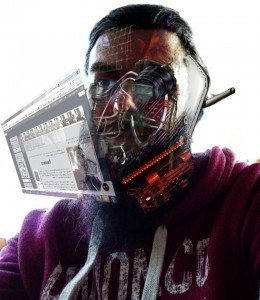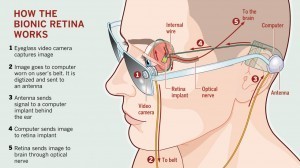Science in Science-Fiction: Neural Jacks and Cyborgs
The previous posts in this series have dealt with a number of topics that are bordering upon the far-realms of science-fiction, technologies that are far removed from our time and knowledge.[caption id="attachment_8146" align="alignleft" width="260"]
 The future of indie authoring?[/caption]This post brings us back down to earth with a bump. The furthest ahead we need to look in these technologies is "twenty minutes in the future".
The future of indie authoring?[/caption]This post brings us back down to earth with a bump. The furthest ahead we need to look in these technologies is "twenty minutes in the future".
Prostheses
The idea of replacing body parts that have been lost, injured or were simply missing is quite an ancient dream. The Peg-leg, hook-hand and glass-eye are recognisable pirate tropes, but are actually far older than any tales of the Spanish Main, (or Caribbean) for that matter.
Ancient Myths and Fairy Tales abound with artificial limbs and organs including Nuada of the Silver Arm and Pelops Ivory shoulder. Ancient history also turns up the occasional artificial hand, leg or —in the case of one Egyptian Mummy— an artificial toe.
Most prosthetics in history are little more than cosmetic (Johnny Depp's original idea for Captain Jack Sparrow had an artificial nose - he was talked out of it) simply a way for a knight on horseback to not reveal he is actually missing an arm or leg, a peg leg may let someone walk around, a hook may let them pull an oar or rope, but just like in myths, science-fiction sees a future where prosthetics are better than the real thing, perhaps even desirable.
Current replacement tech
Right now we are on the brink of science-fiction becoming fact. Modern light-weight composite materials and a better understanding of the energies and forces involved has lead to the modern prosthetic 'blade' allowing Paralympic athletes to run with greater efficiency than flesh and blood limbs can manage, although these are little more than an evolution of the peg-leg they can run at record-breaking speeds.
Legs aren't the only body parts that are starting to match or exceed the properties of biological body parts. Already artificial hands can have greater grip strength than any human arm, and soon we'll see increased lifting strength over a normal arm.
All manner of simple mechanical failures within the body can now be treated with technological
implants, whether we are talking about intestinal or intravenous valves or artificial hips and bones.
Artificial hearts are now reaching a level of technology where they may (within a decade or so) actually outlast natural hearts and extend the lives of those patients they are implanted in, new models are capable of adapting to the body's needs in a way almost identical to the natural feedback systems the heart itself uses, and as our understanding increases so does the sophistication of the hearts.
Although one troubling trend that has appeared recently, and should lend itself to future science-fiction stories (it already made an episode of "Homeland") very well are the possibilities that pace-makers and other implant technologies are lacking in security features and can be remotely hacked and reprogrammed, perhaps even allowing an assassin to kill. There are moves to rectify this trend, but we know that even the NSA makes cyber-security mistakes from time to time.
Artificial Livers, Kidneys, Pancreases and even Lungs are beginning to make an appearance now, with millions of medical dollars being spent on research in stem cell regrowth and external regeneration, where a framework or scaffolding is used to allow the patient's own cells to grow a replacement organ. The most successes so far have been with cartilage tissue structures such as outer ears, noses and even tracheae. With flesh-printers on the way, it will only be a matter of time before artificial flesh can replace almost any damaged muscle or cartilage including the lungs.
As for skin we (or at least the US Army) now has the ability to print skin cells directly onto a burn or wound. As this video shows.
Neural grafting
The biggest problem with all these devices, and especially artificial sense organs (eyes, ears, balance, etc) is that in order for them to work properly you require the prosthetic to communicate with the nervous system and the brain.
While we are getting success with reading the brain now and extracting information from the mind (or at least the motor and visual cortices) we are still making only baby steps with direct neural input.
[caption id="attachment_8149" align="alignright" width="300"] Retinal implants and how they work (so far)[/caption]Retinal implants exist that can tickle the optic nerve to indicate light and dark, but so far we haven't come close to matching the way the eye works, let alone surpassing it. At best the implants give a vague sense of light or dark, colour or blurry images, but this technology is accelerating fast and I wouldn't be too surprised to learn that the military have got some volunteers who have limited day and night-vision after losing their normal sight to an IUD.
Retinal implants and how they work (so far)[/caption]Retinal implants exist that can tickle the optic nerve to indicate light and dark, but so far we haven't come close to matching the way the eye works, let alone surpassing it. At best the implants give a vague sense of light or dark, colour or blurry images, but this technology is accelerating fast and I wouldn't be too surprised to learn that the military have got some volunteers who have limited day and night-vision after losing their normal sight to an IUD.
Cochlea implants are a similar story, they may grant a deaf person partial recovery of some hearing, but they are not able to hear conversations across the street or listen to infrasound or ultra sound, yet. Although it could be argued that modern hearing aids with their "hearing loops" allow the partially hearing to hear radio waves.
Neural Jacks
One day it may be possible to plant not just sensory data, but conceptual data directly into the mind. In effect fixing our memories with digital precision, or granting us skills on a chip. But what about inputing data that is synthetic? This is the central premise of the 1999 movie epic " The Matrix ".
[caption id="attachment_8151" align="alignleft" width="300"] 14 years ago the neural jack looked like this... maybe...[/caption]
14 years ago the neural jack looked like this... maybe...[/caption]
The original concept for this is the Neural Jack, as described by William Gibson in the novel “ Neuromancer ”. Although Gibson stood on the shoulders of giants as he wrote ‘Cyberspace’ into existence he helped define a genre, and may have inadvertently redirected the path of humanity. Would the Internet exist if the Cyberpunks had not branded their way across 80s science-fiction?
Directly communicating with a computer, a virtual reality, even allowing us to share sensory experiences or thoughts, may all one day become possible, with the ultimate goal being the upload of consciousness into a computer to grant us a limited form of immortality. All concepts that I weave together into the Cyberwraiths in the Paradox War trilogy.
Isaac Asimov's take on it is within the I, Robot universe, where humans are demanding robotic replacement parts and the robots start demanding more human replacements, the human race and robots are hybridising and the titular character is a “ Segregationist ” believing the two forms of intelligence should remain separate.
TV embraced the Cyborg quite well, literally in the case of Martin Caidin's novel “ Cyborg ” (1972) who became “ The Six Million Dollar Man ” and along with “ The Bionic Woman ” had kids in the 70s running slowly and shouting “tcha-tcha-tcha-tcha” as they did so. They also added the words bionic and cybernetic to the pop culture lexicon.
Cyborgs moved on through the 80s. With the Terminator representing a robot with an organic skin as its take on the Cybernetic-organism, and “ Robocop ” brought body horror, violence and comedy together for an interesting take on the Cyborg, adding programmed directives to the biological mind of it's subject.
Things did take a turn for the cheesy when Jean-Claude Van Damme had a go at playing one in 1989's (“ Cyborg ”) which almost killed the concept off in Sci-Fi. Though it did lead the way for Angelina Jolie to play one in the totally unrelated (and should probably never have been made) " Cyborg 2" and may have had little or no bearing on the casting of Summer Glau in " Terminator: Sarah Connor Chronicles ".
Which is pretty much the state of the art.
Conclusion
Well, some transhumanists believe that we will inevitably blend ourselves with technology, and await the singularity with baited breath, but if history teaches us anything it says clearly that no futurists are ever completely accurate and so a future of blended people probably will not happen anything like the Cyberpunks imagined.
I think that we will probably augment ourselves eventually, but I'm thinking that these will be more like tattoos or piercings, rather than surgical procedures. Imagine programmable tattoos that you can hide or change as you like. Or subdermal communications technology, injected into the top of your jawbone. Simple procedures that could be performed like modern body modifications, and without fear of rejection or the fabled cyber-psychosis (which makes for neat stories and a good balancing mechanism in roleplaying games, but isn't actually real, as far as we can tell).
I can believe that one day we may have nanobots for medicine that destroy cancer cells, viruses or bacteria that they have been taught to destroy. This kind of augmented, programmable immune system makes sense, with a little nano factory buried in a bone somewhere churning out inoculations based on the latest virus definitions file downloaded from the internet (wonder what a yearly subscription to Bayer-McAfee will cost). Of course the cynical and paranoid will wonder whether the companies will produce viruses to keep their software competitive, something the computer virus companies are accused of from time to time.
With wearable PCs, devices like google glass and so on, we may see cyber-contacts, and perhaps something akin to lasik where the eye can be augmented, but the problem with these implants is always going to be upgrades. Our cyber-tech is obsolete within a few years (anything older than a five years is pretty much dead), would you really want to have upgrade surgery every year or two? Again if we get programmable nanobots of some sort then they will be more likely to be implanted as a simple upgrade could be broadcast to the 'bots. That said we better crack security properly first, as I for one would not welcome having my body functions hacked.
[caption id="attachment_8140" align="alignright" width="300"] Is this an image of our future selves?[/caption]
Is this an image of our future selves?[/caption]
Eventually our far future may involve us as a trans-stellar species reliant on implants to allow us to live natively on planets that we were not naturally adapted to, and even to survive in space with more safety and comfort that we can currently manage. The ability to communicate wordlessly, record and broadcast memories (or imagination!), modify gravity, exert forcefields and radiant beams, and even assemble tools from atoms may be common eventually. I can't really guess what we'll look like then, but perhaps we'll be the Eusaiveans.
 The future of indie authoring?[/caption]This post brings us back down to earth with a bump. The furthest ahead we need to look in these technologies is "twenty minutes in the future".
The future of indie authoring?[/caption]This post brings us back down to earth with a bump. The furthest ahead we need to look in these technologies is "twenty minutes in the future".Prostheses
The idea of replacing body parts that have been lost, injured or were simply missing is quite an ancient dream. The Peg-leg, hook-hand and glass-eye are recognisable pirate tropes, but are actually far older than any tales of the Spanish Main, (or Caribbean) for that matter.
Ancient Myths and Fairy Tales abound with artificial limbs and organs including Nuada of the Silver Arm and Pelops Ivory shoulder. Ancient history also turns up the occasional artificial hand, leg or —in the case of one Egyptian Mummy— an artificial toe.
Most prosthetics in history are little more than cosmetic (Johnny Depp's original idea for Captain Jack Sparrow had an artificial nose - he was talked out of it) simply a way for a knight on horseback to not reveal he is actually missing an arm or leg, a peg leg may let someone walk around, a hook may let them pull an oar or rope, but just like in myths, science-fiction sees a future where prosthetics are better than the real thing, perhaps even desirable.
Current replacement tech
Right now we are on the brink of science-fiction becoming fact. Modern light-weight composite materials and a better understanding of the energies and forces involved has lead to the modern prosthetic 'blade' allowing Paralympic athletes to run with greater efficiency than flesh and blood limbs can manage, although these are little more than an evolution of the peg-leg they can run at record-breaking speeds.
Legs aren't the only body parts that are starting to match or exceed the properties of biological body parts. Already artificial hands can have greater grip strength than any human arm, and soon we'll see increased lifting strength over a normal arm.
All manner of simple mechanical failures within the body can now be treated with technological
implants, whether we are talking about intestinal or intravenous valves or artificial hips and bones.
Artificial hearts are now reaching a level of technology where they may (within a decade or so) actually outlast natural hearts and extend the lives of those patients they are implanted in, new models are capable of adapting to the body's needs in a way almost identical to the natural feedback systems the heart itself uses, and as our understanding increases so does the sophistication of the hearts.
Although one troubling trend that has appeared recently, and should lend itself to future science-fiction stories (it already made an episode of "Homeland") very well are the possibilities that pace-makers and other implant technologies are lacking in security features and can be remotely hacked and reprogrammed, perhaps even allowing an assassin to kill. There are moves to rectify this trend, but we know that even the NSA makes cyber-security mistakes from time to time.
Artificial Livers, Kidneys, Pancreases and even Lungs are beginning to make an appearance now, with millions of medical dollars being spent on research in stem cell regrowth and external regeneration, where a framework or scaffolding is used to allow the patient's own cells to grow a replacement organ. The most successes so far have been with cartilage tissue structures such as outer ears, noses and even tracheae. With flesh-printers on the way, it will only be a matter of time before artificial flesh can replace almost any damaged muscle or cartilage including the lungs.
As for skin we (or at least the US Army) now has the ability to print skin cells directly onto a burn or wound. As this video shows.
Neural grafting
The biggest problem with all these devices, and especially artificial sense organs (eyes, ears, balance, etc) is that in order for them to work properly you require the prosthetic to communicate with the nervous system and the brain.
While we are getting success with reading the brain now and extracting information from the mind (or at least the motor and visual cortices) we are still making only baby steps with direct neural input.
[caption id="attachment_8149" align="alignright" width="300"]
 Retinal implants and how they work (so far)[/caption]Retinal implants exist that can tickle the optic nerve to indicate light and dark, but so far we haven't come close to matching the way the eye works, let alone surpassing it. At best the implants give a vague sense of light or dark, colour or blurry images, but this technology is accelerating fast and I wouldn't be too surprised to learn that the military have got some volunteers who have limited day and night-vision after losing their normal sight to an IUD.
Retinal implants and how they work (so far)[/caption]Retinal implants exist that can tickle the optic nerve to indicate light and dark, but so far we haven't come close to matching the way the eye works, let alone surpassing it. At best the implants give a vague sense of light or dark, colour or blurry images, but this technology is accelerating fast and I wouldn't be too surprised to learn that the military have got some volunteers who have limited day and night-vision after losing their normal sight to an IUD.Cochlea implants are a similar story, they may grant a deaf person partial recovery of some hearing, but they are not able to hear conversations across the street or listen to infrasound or ultra sound, yet. Although it could be argued that modern hearing aids with their "hearing loops" allow the partially hearing to hear radio waves.
Neural Jacks
One day it may be possible to plant not just sensory data, but conceptual data directly into the mind. In effect fixing our memories with digital precision, or granting us skills on a chip. But what about inputing data that is synthetic? This is the central premise of the 1999 movie epic " The Matrix ".
[caption id="attachment_8151" align="alignleft" width="300"]
 14 years ago the neural jack looked like this... maybe...[/caption]
14 years ago the neural jack looked like this... maybe...[/caption]The original concept for this is the Neural Jack, as described by William Gibson in the novel “ Neuromancer ”. Although Gibson stood on the shoulders of giants as he wrote ‘Cyberspace’ into existence he helped define a genre, and may have inadvertently redirected the path of humanity. Would the Internet exist if the Cyberpunks had not branded their way across 80s science-fiction?
Directly communicating with a computer, a virtual reality, even allowing us to share sensory experiences or thoughts, may all one day become possible, with the ultimate goal being the upload of consciousness into a computer to grant us a limited form of immortality. All concepts that I weave together into the Cyberwraiths in the Paradox War trilogy.
Isaac Asimov's take on it is within the I, Robot universe, where humans are demanding robotic replacement parts and the robots start demanding more human replacements, the human race and robots are hybridising and the titular character is a “ Segregationist ” believing the two forms of intelligence should remain separate.
TV embraced the Cyborg quite well, literally in the case of Martin Caidin's novel “ Cyborg ” (1972) who became “ The Six Million Dollar Man ” and along with “ The Bionic Woman ” had kids in the 70s running slowly and shouting “tcha-tcha-tcha-tcha” as they did so. They also added the words bionic and cybernetic to the pop culture lexicon.
Cyborgs moved on through the 80s. With the Terminator representing a robot with an organic skin as its take on the Cybernetic-organism, and “ Robocop ” brought body horror, violence and comedy together for an interesting take on the Cyborg, adding programmed directives to the biological mind of it's subject.
Things did take a turn for the cheesy when Jean-Claude Van Damme had a go at playing one in 1989's (“ Cyborg ”) which almost killed the concept off in Sci-Fi. Though it did lead the way for Angelina Jolie to play one in the totally unrelated (and should probably never have been made) " Cyborg 2" and may have had little or no bearing on the casting of Summer Glau in " Terminator: Sarah Connor Chronicles ".
Which is pretty much the state of the art.
Conclusion
Well, some transhumanists believe that we will inevitably blend ourselves with technology, and await the singularity with baited breath, but if history teaches us anything it says clearly that no futurists are ever completely accurate and so a future of blended people probably will not happen anything like the Cyberpunks imagined.
I think that we will probably augment ourselves eventually, but I'm thinking that these will be more like tattoos or piercings, rather than surgical procedures. Imagine programmable tattoos that you can hide or change as you like. Or subdermal communications technology, injected into the top of your jawbone. Simple procedures that could be performed like modern body modifications, and without fear of rejection or the fabled cyber-psychosis (which makes for neat stories and a good balancing mechanism in roleplaying games, but isn't actually real, as far as we can tell).
I can believe that one day we may have nanobots for medicine that destroy cancer cells, viruses or bacteria that they have been taught to destroy. This kind of augmented, programmable immune system makes sense, with a little nano factory buried in a bone somewhere churning out inoculations based on the latest virus definitions file downloaded from the internet (wonder what a yearly subscription to Bayer-McAfee will cost). Of course the cynical and paranoid will wonder whether the companies will produce viruses to keep their software competitive, something the computer virus companies are accused of from time to time.
With wearable PCs, devices like google glass and so on, we may see cyber-contacts, and perhaps something akin to lasik where the eye can be augmented, but the problem with these implants is always going to be upgrades. Our cyber-tech is obsolete within a few years (anything older than a five years is pretty much dead), would you really want to have upgrade surgery every year or two? Again if we get programmable nanobots of some sort then they will be more likely to be implanted as a simple upgrade could be broadcast to the 'bots. That said we better crack security properly first, as I for one would not welcome having my body functions hacked.
[caption id="attachment_8140" align="alignright" width="300"]
 Is this an image of our future selves?[/caption]
Is this an image of our future selves?[/caption]Eventually our far future may involve us as a trans-stellar species reliant on implants to allow us to live natively on planets that we were not naturally adapted to, and even to survive in space with more safety and comfort that we can currently manage. The ability to communicate wordlessly, record and broadcast memories (or imagination!), modify gravity, exert forcefields and radiant beams, and even assemble tools from atoms may be common eventually. I can't really guess what we'll look like then, but perhaps we'll be the Eusaiveans.
Published on October 31, 2013 17:05
No comments have been added yet.



